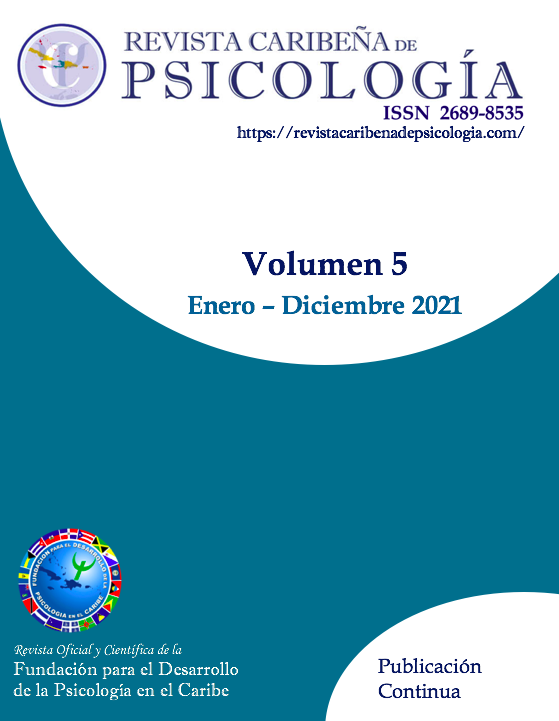When Compassion Moves Us: It Presents at Work
DOI:
https://doi.org/10.37226/rcp.v5i1.5605Keywords:
compassion at work, psychometry, positive psychologyAbstract
Compassion at work has recently been studied as a relevant construct to promote the well-being of employees, the organizational goals’ achievement, and the quality of organizational life. The main objective of this study was to analyze the psychometric properties of a battery of items in order to develop three scales to study compassion at work (individual compassion, compassion of co-workers and organizational compassion) in the Hispanic work context. The sample consisted of 443 persons from various labor sectors in Puerto Rico. The results confirm a factorial structure of three sub-scales (cognition, affection and behaviors) to measure individual compassion, a one-dimensional scale to measure the compassion of co-workers, and a two-dimensional scale (compassionate policies and practices), all with good psychometric properties. We conclude that the three instruments measuring compassion at work are appropriate instruments for use in the Puerto Rican labor context, in addition to being a contribution to the scientific literature of occupational psychology.
References
Avramchuk, A. S. & Manning, M. R. (2014). Executive compas-sion: How executives construe compassion at work. Current Topics in Management, Center for Advanced Studies in Man-agement, 17, 129-153.
Ato, M., & López, J.J., & Benavente, A. (2013). Un sistema de clasificación de los diseños de investigación en psicología. Anales de Psicología, 29(3),1038-1059. https://www.redalyc.org/articulo.oa?id=16728244043
Barbot, J. & Dodier, N. (2015). Dealing with compassion at work: strategic reflexivity among court lawyers. Sociologie du travail, 57, 43-62. https://doi.org/10.1016/j.soctra.2015.09.009
Blau, F. M. (1964). Exchange and power in social life. Wiley.
Bowlby, J. (1969). Attachment and loss: Vol. 1 Attachment. Basie Books.
Bowlby, J. (1973). Attachment and loss: Vol. 2. Separation: Anxiety and anger. Basic Books.
Brown, T.A. (2015). Confirmatory factor analysis for applied research (2nd ed.). Guilford Press.
Cameron, K. (2017). Organizational compassion: manifestations through organizations. En S. L., Worline, M. C., Cameron, C. D., & Doty, J. R. (Eds.), The Oxford Handbook of Compassion Sci-ence (421-431). Oxford University Press.
Cameron, K., Mora, C., Leutscher, T. & Calarco, M. (2011). Ef-fects of positive practices on organizational effectiveness. Journal of Applied Behavioral Science, 47(3), 266-308. https://doi.org/10.1177/0021886310395514
Choi, H.J., Lee, S., No, S.R. & Kim, E.I. (2016). Effects of compas-sion on employees’ self-regulation. Social Behavior and Personal-ity, 44(7), 1173–1190. https://doi.org/10.2224/sbp.2016.44.7.1173
Chu, L.C. (2014). Mediating positive moods: the impact of expe-riencing compassion at work. Journal of Nursing Management, 24, 59–69. https://doi.org/10.1111/jonm.12272
Davis, M. H. (1983). The effect of dispositional empathy on emo-tional reactions and helping: a multidimensional approach. Journal of Personality, 51, 167-184. https://doi.org/10.1111/j.1467-6494.1983.tb00860.x
Dutton, J.E., Workman, K.M., & Hardin, A.E. (2014). Compassion at work. Annual Review of Organizational Psychology and Organ-izational Behavior, 1, 277-304. https://doi.org/10.1146/annurev-orgpsych-031413-091221
Fornell, C., & Larcker, D.F. (1981). Evaluating structural equation models with unobservable variables and measurement error. Journal of Marketing Reasearch, 18(2), 39-50. https://doi.org/10.2307/3151312
Gilbert, P. (2018). La mente compasiva: una nueva forma de enfrentarse a los desafíos vitales. Editorial Eleftheria.
Hernández-Sampieri, R., Fernández-Collado, C., & Baptista-Lucio, P. (2006). Analisis de los datos cuantitativos. Metodología de la investigación, 407-499.
Hur, W.M., Moon, T. & Rhee, S.Y. (2016a). Exploring the relation-ship between compassion at work: the evaluative perspective of positive work-related identity, service employee creativity, and job performance. Journal of Service Markeing, 30(1), 103-114. https://doi.org/10.1108/JSM-05-2014-0180
Hur, W.M., Moon, T.W. & Ko, S.H. (2016b). How employees’ perceptions of CSR increase employee creativity: mediating mechanisms of compassion at work and intrinsic motivation. Springer Science+Business Media Dordrecht. https://doi.org/10.1007/s10551-016-3321-5
Kline, T. J. (2005). Psychological testing: a practical approach to design and evaluation. Sage Publications.
Ledoux, K., Forchuk, C, Higgins, C. & Rudnick, A. (2018). The effect of organizational and personal variables on the ability to practice compassionately. Journal of Applied Nursing Research, 41, 15-20. https://doi.org/10.1016/j.apnr.2018.03.001
Mertens, D. (2004). Research and Evaluation in Education and Psychology: Integrating Diversity with Quantitative, Qualita-tive, and Mixed Methods.
Montero, I., & León, O. G. (2007). A guide for naming research studies in psychology. International Journal of Clinical and Health Psychology, 7(3), 847–862.
Lilius, J.M., Worline, M.C., Maitlis, S., Kanov, J. Dutton, J.E., & Frost, P. (2008). The contours and consequences of compas-sion at work. Journal of Organizational Behavior, 29, 193-218. https://doi.org/10.1002/job.508
Lupoli, M.J., Jampol, L. & Oveis, C. (2017). Lying because we care: compassion increases prosocial lying. Journal of Experi-mental Psychology: General, 146(7), 1026-1042. https://doi.org/10.1037/xge0000315
Madden, L.T., Duchon, D. & Plowman, D.A. (2012). Emergent organizational capacity for compassion. Academy of Manage-ment Review, 37(4), 689-708. http://dx.doi.org/!0.5465/amr.2010.0424
Martínez Lugo, M., Méndez Collada, V., & Maeso Flores, R. (1999). La centralidad de trabajo y los intereses de vida en una muestra de empleados jóvenes y envejecidos en Puerto Rico. Revista Puertorriqueña de Psicología, 12, 77-91.
Martínez, M. E., Morales, O., Rodríguez, O., Rosa, W., & Sánchez, S. (2016). Civilidad, incivilidad y el bienestar asociado al traba-jo en un grupo de personas empleadas en Puerto Rico. Revista Interamericana de Psicología Ocupacional, 28(1), 45-55.
Moon, T.W., Hur, W.M., Ko, S.H., Kim, J.W., & Yoon, S.W. (2014). Bridging corporate social responsibility and compassion at work: relations to organizational justice and affective organi-zational commitment. Career Development International, 19(1), 49-72.
Moon, T.W., Hur, W. M., Ko, S.H., Kim, J.W. & Yoo, D.K. (2016). Positive work-related identity as a mediator of the relation-ship between compassion at work and employee outcomes. Human Factors and Ergonomics in Manufacturing & Service Indus-tries, 26(1) 84–94. https://doi.org/10.1108/CDI-05-2013-0060
Pommier, E. A. (2011). The Compassion Scale. Dissertation Ab-stracts International Section A: Humanities and Social Science, 72, 1174.
Ray, S.L., Wong, C., White, D. & Heaslip, K. (2013). Compassion satisfaction, compassion fatigue, work life conditions, and burnout among frontline mental health care professionals. Traumatology, 19(4), 255-267. https://doi.org/10.1177/1534765612471144
Reich, W. T. (1989). Speaking of suffering: A moral account of compassion. Soundings, 72, 83-108. http://www.jstor.org/stable/41178467
Rhee, S.Y., Hur, W.M. & Kim, M. (2017). The relationship of coworker incivility to job performance and the moderating role of self-efficacy and compassion at work: the Job De-mands-Resources (JD-R) Approach. Journal of Bussiness Psychology, 32, 711-726. https://doi.org/10.1007/s10869-016-9469-2
Rodríguez-Montalbán, R. (2018). La compasión en el entorno laboral: concepto y medida. Protocolo IRB núm. Fall 1822. Universidad Carlos Albizu, San Juan, PR.
Rosario-Hernández, E., Millán, L. V. R., Rivera, L., Rivera, G., Padovani, C., Plaza, Y., & Gallardo, R. (2016). La incivilidad en el lugar de trabajo y su relación con el bienestar psicológico en una muestra de empleados en Puerto Rico. Revista Inter-americana de Psicología Ocupacional, 29(1), 5-19.
Rosario-Hernández, E., Millán, L. V. R., Rodríguez Irizarry, A., Velázquez Lugo, Á. V., Rosario Nieves, I. R., & Zapata Solá, A. Z. (2013). La relación entre la manifestación de conductas la-borales contraproducentes, estresores laborales, emociones y acoso psicológico: El efecto moderador de las emociones nega-tivas. Revista Interamericana de Psicología Ocupacional, 32(1), 31-52.
Salanova, M. & Schaufeli, W.B. (2000). Exposure to information technologies and its relation to burnout. Behavior & Infor-mation Technology, 19, 385-392. https://doi.org/10.1080/014492900750000081
Satorra, A. & Bentler, P. (2001). A scaled difference chi-square test statistic for moment structure analysis. Psychometrika, 66(4), 507-514. https://doi.org/10.1007/BF02296192
Stamm, B. H. (2010). The concise ProQOL manual (2nd ed.), Poca-tello, ID: ProQOL.org.
Velasco, M., Navarro, J. & Rueff-Lopes, R. (2015). Teoría de los acontecimientos afectivos: Revisión de su impacto y desarro-llos en el estudio del afecto en las organizaciones. Revista Psi-cología: Organizações e Trabalho. 17, 30-38. http://dx.doi.org/10.17652/rpot/2017.1.12106
Wagaman, M. A., Geiger, J.M., Schockley, C. & Segal, E.A. (2015). The role of empathy in burnout, compassion satisfaction, and secondary traumatic stress among social workers. National As-sociation of Social Workers, 201-209. https://doi.org/10.1093/sw/swv014
Weiss, H. M., & Cropanzano, R. (1996). Affective events theory: A theoretical discussion of the structure, causes and conse-quences of affective experiences at work. In B. M. Staw & L. L. Cummings (Eds.), Research in organizational behavior: An an-nual series of analytical essays and critical reviews, (Vol. 18, pp. 1-74). Greenwich: Elsevier Science/JAI Press.
Worline, M. C. & Dutton, J. E. (2017). Awakening compassion at work: the quiet power that elevates people and organizations. Be-rrett-Koehler Publishers.
Published
How to Cite
Issue
Section
License
Copyright (c) 2021 Luis A. Pedraza González, Ramón Rodríguez Montalbán, Miguel Martínez Lugo

This work is licensed under a Creative Commons Attribution 4.0 International License.







